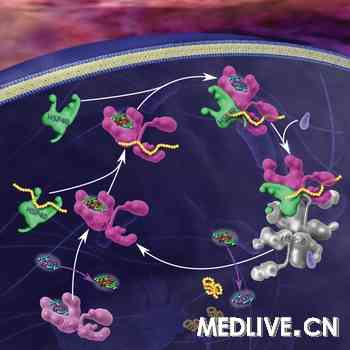PNAS:致癌激酶的天然陷阱
| 导读 |
雌性果蝇中的Mtrm基因只在卵细胞发育过程中具有活性。现在Stowers医学研究所的研究人员发现,Mtrm蛋白能够诱捕强大的Polo激酶,并使其失活,文章发表在本周的美国国家科学院院刊PNAS杂志上。Polo激酶被认为是细胞分裂的主要调节者,而与之相对应的人类Polo样激酶1(Plk1)与多种癌症有关。
Polo样激酶1在癌症中的作用很关键,能够... |

雌性果蝇中的Mtrm基因只在卵细胞发育过程中具有活性。现在Stowers医学研究所的研究人员发现,Mtrm蛋白能够诱捕强大的Polo激酶,并使其失活,文章发表在本周的美国国家科学院院刊PNAS杂志上。Polo激酶被认为是细胞分裂的主要调节者,而与之相对应的人类Polo样激酶1(Plk1)与多种癌症有关。
Polo样激酶1在癌症中的作用很关键,能够促进癌细胞的增殖,许多药物研发人员都在尝试抑制这种激酶的致癌作用。文章的资深作者,Stowers医学研究所的R. Scott Hawley博士指出,Mtrm蛋白诱捕Polo激酶具有高度的选择性,不会影响正常细胞中的其他重要激酶。他希望这项研究能够为药物人员提供抑制Polo激酶的新途径。“我们的发现将给,正在寻找Polo激酶抑制剂的药物研发者们带来新的希望,”Hawley说。
Stowers医学研究所的研究人员在果蝇(Drosophila melanogaster)中揭示了,卵细胞Matrimony(Mtrm)使Polo激酶失活的机制。Hawley将Mtrm结合并抑制Polo的方法形象地称为“捕鼠器模式”。Matrimony蛋白只在卵细胞发育过程(或卵母细胞)中表达,其N末端为Polo激酶提供了“诱饵”,此处的三个磷酸化氨基酸模拟Polo最喜爱的标准结合位点,磷酸化丝氨酸或磷酸化苏氨酸残基。
Hawley解释道,“我们认为,Matrimony的N端区域形成一个诱饵。这对于Polo来说,就像是其标准结合位点在向它招手。”一旦Polo吞饵上钩,Matrimony的C端就会将Polo环绕起来,抑制其功能。
“在几乎所有的分裂细胞中,Polo都位于调控机制的最高层,”Hawley说。“被Polo磷酸化的目标,会继续使其他靶标磷酸化或去磷酸化,由此影响着细胞分裂中的每个调控通路。而卵细胞需要关闭Polo功能来进行分裂,这是一个很有意思的例外。”
Hawley于2003年发现了Matrimony基因,随后Hawley实验室发现,在卵细胞发育过程中,Mtrm是细胞分裂的一个关键因子。研究人员先在雌性果蝇中去除了Mtrm基因的一个拷贝,发现卵母细胞仍然能够完成两轮减速分裂,不过染色体发生缺陷的风险很高。然后他们又在雌性果蝇中敲除了两个拷贝的Mtrm基因,发现卵母细胞中染色体和其他细胞分裂所需结构,都遭到了灾难性的破坏。
研究显示,Mtrm能够通过关闭Polo来促进减数分裂。为了阐明Mtrm与Polo的作用机制,研究人员进行了七年研究,并且在活卵母细胞中跟踪观察了Mtrm与Polo的相互作用。他们指出,Mtrm是一种能与Polo激酶结合并使其关闭的罕见天然蛋白。
这项研究找到了一种能够抑制Polo激酶的天然蛋白,该蛋白能够高度特异地结合Polo,而不会造成其他影响。在许多癌症类型中,Polo调节都发生了故障,而这项发现将为靶标Polo治疗癌症带来新的启示。
原文摘要:
Binding of Drosophila Polo kinase to its regulator Matrimony is noncanonical and involves two separate functional domains
Drosophila melanogaster Polo kinase physically interacts with, and is repressed by, the Matrimony (Mtrm) protein during oogenesis. Females heterozygous for a deletion of the mtrm gene display defects in chromosome segregation at meiosis I. However, a complete absence of Mtrm results in both meiotic catastrophe and female sterility. We show that three phosphorylated residues in an N-terminal region in Mtrm are required for Mtrm::Polo binding. However, this binding is noncanonical; it does not require either a complete S-pS/pT-P motif in Mtrm or key residues in the Polo-box domain of Polo that allow Polo to bind phosphorylated substrates. By using fluorescence cross-correlation spectroscopy to characterize the Mtrm::Polo interaction in vivo, we show that a sterile α-motif (SAM) domain located at the C terminus of Mtrm increases the stability of Mtrm::Polo binding. Although Mtrm’s C-terminal SAM domain is not required to rescue the chromosome segregation defects observed in mtrm/+ females, it is essential to prevent both meiotic catastrophe and the female sterility observed in mtrm/mtrm females. We propose that Polo’s interaction with the cluster of phosphorylated residues alone is sufficient to rescue the meiosis I defect. However, the strengthening of Mtrm::Polo binding mediated by the SAM domain is necessary to prevent meiotic catastrophe and ensure female fertility. Characterization of the Mtrm::Polo interaction, as well as that of other Polo regulators, may assist in the design of a new class of Polo inhibitors to be used as targeted anticancer therapeutic agents.
来源:生物通
 腾讯登录
腾讯登录
还没有人评论,赶快抢个沙发